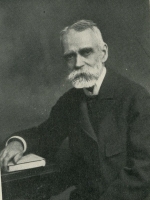History

"A librarian should be as unwilling to allow an inquirer to leave the library with his question unanswered as a shopkeeper is to have a customer go out of the store without making a purchase."
Samuel Swett Green (left), Head Librarian, 1867-1909
Establishment and Early Years of WPL
On December 23, 1859, the Worcester City Council passed an ordinance establishing the Worcester Public Library and accepted a gift of 7,000 books Dr. John Green III, and 4,000 books from the Worcester Lyceum and Library Association to jumpstart the new collection. Worcester Public Library opened its doors to the public on April 30, 1860 on the third floor of the Bank Block at Foster and Main Streets. By 1861, the Library occupied a new building at Elm Street (now the site of the Pearl Elm Garage) where it was to remain for the next 100 years. An addition to the original structure was built in 1891, and the small building known as the children's entrance was added in 1900.

Zephiniah Baker served as Head Librarian until 1867. His successor, Samuel Swett Green, nephew of Dr. John Green, is internationally renowned for his contributions to public librarianship, including encouraging cooperation between libraries and schools, developing collections of reference materials, adding books in languages other than English, and promoting Sunday hours. During Samuel S. Green's tenure, the Library was open 365 days a year.
Community Branches
The Greendale (now Frances Perkins), Quinsigamond, and South Worcester branches were built in 1914 with funds provided by Andrew Carnegie and on land provided by Worcester industrialists. Carnegie himself came to Worcester for the laying of the cornerstones for the new buildings. The Billings Square Branch opened in 1928, the Tatnuck Branch in 1940, the Main South Branch in 1945, and the Great Brook Valley Branch in 1981. All branches were closed in 1990. However, Great Brook Valley reopened within a few months, and Greendale (Frances Perkins) resumed operations in 1992.

Salem Square Location
Overcrowding was an issue at WPL from the beginning and, in 1953, the Board of Directors asked for space for a new Main Library building as part of the Salem Square Redevelopment Project. Land was purchased for that purpose in 1959, the year WPL celebrated its 100th anniversary. The Library moved into its new location at 3 Salem Square in 1964. Over the next few decades, it became apparent that more space was needed and plans for extensive renovations of the existing building were formulated. The project was shepherded through by WPL's first female Head Librarian, Penelope B. Johnson. After a two-year stay at a temporary location at 160 Fremont Street, WPL moved into a beautifully updated building with a modern new addition on October 22, 2001.
One City, One Library Initiative
Between 2013 and 2016, Worcester Public Library opened four branches in public elementary schools in partnership with the City of Worcester, Worcester Public Schools, and private community partners. The Roosevelt Branch, Tatnuck Magnet Branch, Goddard Branch, and Burncoat Branch provide students, teachers, and the public with a wealth of resources, including books, magazines, electronic databases, audio material and much more. The initiative was created in response to an overwhelming need to help our city’s students achieve grade-level reading proficiency.
Mobile Libraries
In addition to these branches, Libby and Lilly, the WPL’s Mobile Libraries, make an impact in our community by delivering public library resources across the city. Since 1940, intermittent bookmobile services had been offered in the city of Worcester. These services played an important outreach role, connecting new users and raising awareness of library services. In 1991, the services were discontinued. However, on Monday, June 4, 2012, the Worcester Public Library announced the official launch of its new Mobile Library Branch, Library Express (Libby), with an additional bookmobile “Lilly” launched in January of 2014.
“Writing the Next Chapter” 2021 Renovation
In 2021, the Worcester Public Library completed a renovation that is critical to its ability to continue serving the needs of the entire community, while also contributing to the renaissance taking place in downtown Worcester. As one of the city’s greatest assets, it is crucial that the Library continues to grow and change to meet the needs of patrons. The renovation project has opened up the Library to the Worcester Common by creating a new entrance on Franklin Street. This entrance will help us contribute to the vibrancy of the up-and-coming neighborhood, while making it easier to connect with people in the heart of downtown.

Finally, the children’s room has been relocated to the third floor, offering a more secure location, with its own restroom facilities and controlled points of entry. The new Arthur M. and Martha R. Pappas Children’s Center fosters independence, as well as group engagement with a variety of spaces and activities for children of all ages.
Your Community Library
Generations of Worcesterites have come to love their library and depend upon the services it provides. In addition, Worcester residents of all ages instantly recognize familiar WPL icons, including the WRDSMTH mural on the exterior of the building, the WPL owls, the Artifakt Studios mural leading to the Children’s Center, the copper panels that were part of the original entrance to the library when it opened in 1964, and the art glass doors designed by artist Stephen Knapp which grace the entrances of the Salem Square building.
It is essential that the spaces and services of the Worcester Public Library grow and change in order to meet the needs of current and future library users. The population of the City of Worcester has also changed over time, and will continue to transform in the years to come. The Library structure continues to evolve in order to better support new technologies being deployed, new programs being offered, and a more diverse population.

Additional Information:

